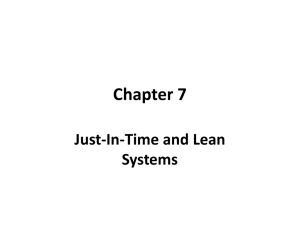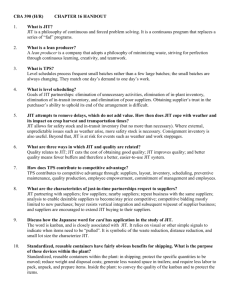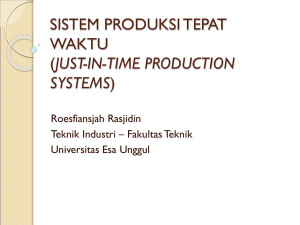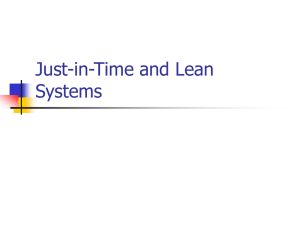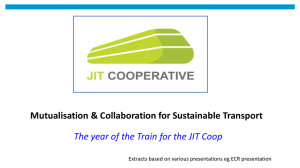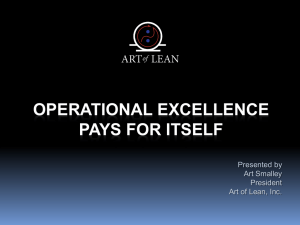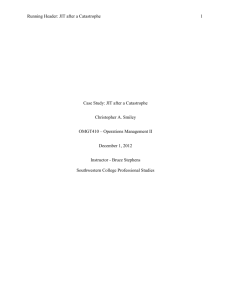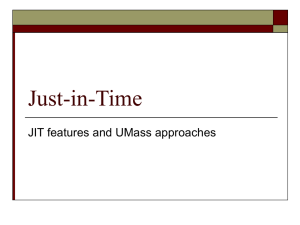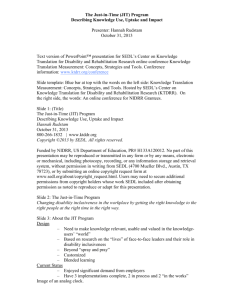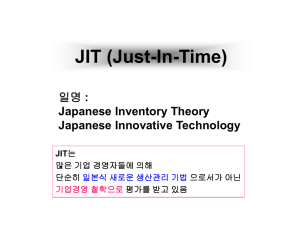Lean Management - Revisionstation
advertisement
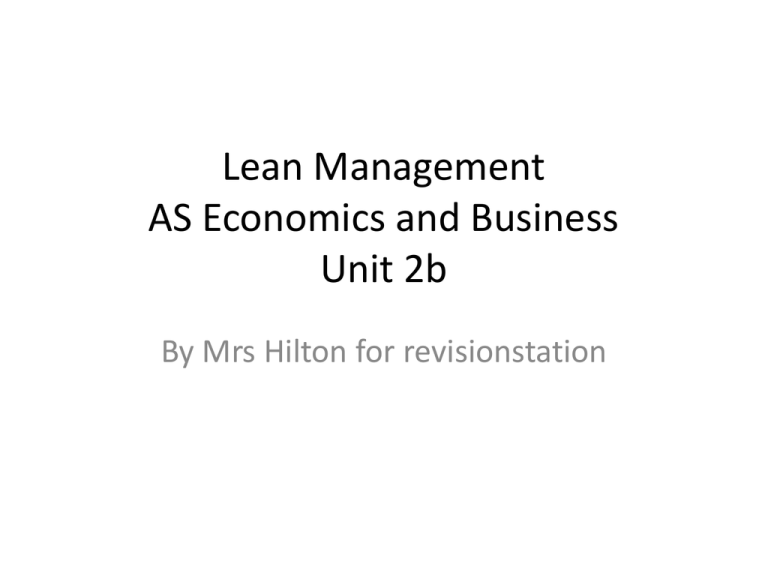
Lean Management AS Economics and Business Unit 2b By Mrs Hilton for revisionstation Lesson Objectives • To be able to discuss Just in Time (JIT) management of stock • To be able to identify how short product development lead-times can give a business competitive advantage • To be able to discuss how minimising waste of resources can give a business competitive advantage • To be able to answer a past paper question based on the topic Starter • You have two cats. • Each cat eats 2 pouches of wet food a day (one at 6 am one at 2pm) • Each cat also eats 25g of go-Kat dry food a day • You shop once a week and only have limited money • How much cat food a week do you buy? • Is there an efficient way to ensure that you never run out of cat food other than buying loads and loads of cat food and stockpiling? • What if you don’t have the storage space? • What if you have a tight weekly budget? • What is your re-order point? Just-in-time • A customer order pulls the parts through the system to the finished product – built to order • In a car manufacturer customers can select seats, trim, options and colour. Parts are ordered as the car moves through production. Seats arrive just as they are needed. Advantages of JIT • As parts are ordered as they are needed there is no wastage which fits the TQM theory of zero wastage • Parts are not warehoused which is a massive cost saving in terms of premises and staff • Less capital tied up in stock, therefore reduced average costs of production of each item JIT and suppliers • To make JIT work the large manufacturer needs to haver excellent working relationships with their smaller parts suppliers. • JIT does not work when there are delivery or quality issues • No buffer stocks are held in a JIT system so if delivery does not arrive the product cannot be made JIT and employees • Employees of the business may need training to help them work with a JIT / Kanban system • They may for part of a quality circle or of a Kaizen team and are encouraged to sort problems on the equipment that they work with. Short product development lead times • The quicker a business can get an idea to a fully working product the sooner they will gain: • Competitive advantage • First mover advantage • Short lead-times that is from design to final product mean that a business can respond quickly to new trends Minimising waste of resources Sample question 1 [4] Answer question 1 Correct answer is D • JIT stock management is a stock control method which relies on no buffer stock and/or has regular deliveries from suppliers when required (1 mark). • Nissan’s capital expenditure of stock will therefore be less than traditional stock control methods as stock is not stored (1 mark) • Less capital will be required to store/warehouse the stock (1 mark). • Employee training may not necessarily change/decrease as there could be a need for more employee training to cope with the JIT system (1 mark). • There will be a decreased not an increase in product defects by using JIT as quality improves using JIT/lean management techniques (1 mark) • Average Costs are more likely to decrease rather than increase due to having less stock holding costs (1 mark) Any acceptable answer which shows selective knowledge/understanding/application and/or development NB up to 2 marks out of 3 may be gained for part (b) if part (a) is incorrect • Maximum 2 marks for explaining why distracters are incorrect Sample question 2 [4] Answer question 2 Correct answer is C • JIT involves the use of minimal stock levels, i.e. no buffer stocks. (1 mark) • This will mean more frequent deliveries rather than a decrease in deliveries order to maintain fully stocked shelves in the supermarket. (1 mark) • JIT will lead to a fall in average costs rather than an increase as capital is not tied up in stock. (1 mark) • There will be a closer relationship with suppliers as deliveries are made more frequently so Aldi will need to have more contact with suppliers. (1 mark) • This will lead to a reduction in stock levels not an increase in stock levels as stock is only ordered as it is required (1 mark) Any acceptable answer which shows selective knowledge/understanding/application and/or development NB up to 2 marks out of 3 may be gained for part (b) if part (a) is incorrect Maximum 2 marks for explaining why distracters are incorrect Sample question 3 Answer question 3 Knowledge 1, Application 1, Analysis 2 Knowledge: up to 1 mark are available for explaining what is meant by JIT (1 mark). E.g. no buffer stocks are kept Application: up to 1 mark is available for explaining how JIT can help TVS to reduce costs due to less storage (1 mark) and therefore increasing profit margins (1 mark) or lead to a competitive advantage in price for TVS (1 mark) or similar use of context. Analysis: up to 2 marks are available for developing the above and showing how JIT may reduce lead times (1 mark) and/or sales pulling orders (1 mark). More able candidates may see the benefits in terms of opportunity costs (1 mark). Sample question 4 • [4] Answer question 4 • Correct answer is D less wastage • Lean management is an approach by business to increase efficiency (1 mark) in which may include just in time production/ short product development leads times / minimising waste (1 mark). • Lean management aims to remove waste whilst maintaining quality (1 mark). • Stock levels using JIT will be minimised rather than increased by using Lean management (1 mark). • Labour Intensity will either remain the same or will have no impact on the use of lean management (1 mark). • Excess capacity should be reduced with lean management as the business is more efficient (1 mark). Any acceptable answer which shows selective knowledge/understanding/application and/or development NB up to 2 marks out of 3 may be gained for part (b) if part (a) is incorrect Maximum 2 marks for explaining why distracters are incorrect Revision Video
